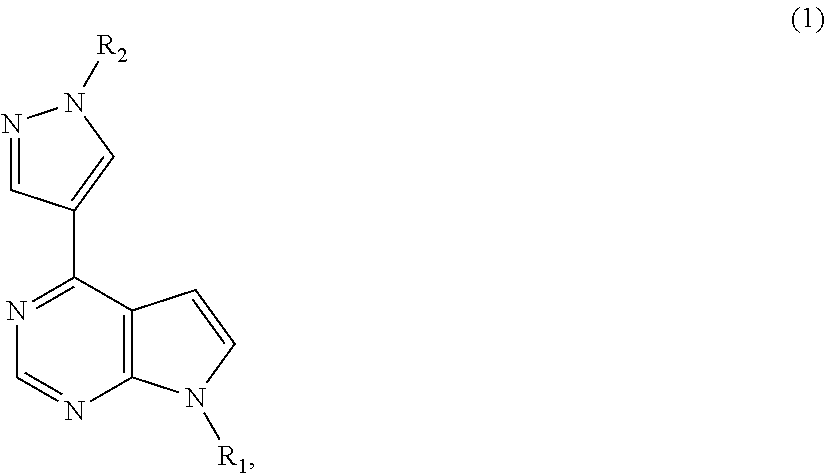Baricitinib intermediate, method for forming baricitinib intermediate, and method for preparing baricitinib or pharmaceutically acceptable salt thereof
a technology of baricitinib and intermediate, which is applied in the field of baricitinib intermediate, and the method of preparing baricitinib or a pharmaceutically acceptable salt thereof, and achieves the effect of economic us
- Summary
- Abstract
- Description
- Claims
- Application Information
AI Technical Summary
Benefits of technology
Problems solved by technology
Method used
Image
Examples
example 1
[0059]Synthesis of (4-chloro-7H-pyrrolo[2,3-d]pyrimidin-7-yl)methyl pivalate
[0060]To a solution of 4-chloro-1H-pyrrolo[2,3-b]pyridine (5.0 g, 32.56 mmol) in dimethylformamide (DMF) (20 mL), K2CO3 (5.4 g, 39.07 mmol) was added. The solution was stirred at room temperature, and chloromethyl pivalate (5.5 g, 36.52 mmol) was added dropwise into the solution at room temperature. The reaction mixture was stirred at room temperature for 16 hours. Water (50 mL) was added to the resulting solution, and the resulting suspension was stirred at room temperature for 2 hours. The solids were collected by filtration, washed with water (10 mL×2), and dried under vacuum to give (4-chloro-7H-pyrrolo[2,3-d]pyrimidin-7-yl)methyl pivalate (8.47 g) as an off-white solid.
example 2
[0061]Synthesis of (4-(1-(tetrahydro-2H-pyran-2-yl)-1H-pyrazol-4-yl)-7H-pyrrolo[2, 3-d]pyrimidin-7-yl)methyl pivalate
[0062]To a suspension of (4-chloro-7H-pyrrolo[2,3-d]pyrimidin-7-yl)methyl pivalate (5 g, 18.68 mmol) in 1,4-dioxane (50 mL), 1-(tetrahydro-2H-pyran-2-yl)-1H-pyrazole-4-boronic acid pinacol ester (denoted as TAPE hereinafter) (6.23 g, 22.40 mmol) and K2CO3 (5.16 g, 37.34 mmol) / H2O (15 mL) were added at room temperature under nitrogen atmosphere. Pd(PPh3)2Cl2 (0.262 g, 0.02 mmol) was added and the resulting mixture was heated to reflux (about 72° C.) for 3 hours. When the reaction was deemed to complete, the reaction mixture was cooled to room temperature and diluted with ethyl acetate (80 mL). The two layers were separated, and the aqueous layer was extracted with ethyl acetate (80 mL). The combined organic phase was dried over MgSO4 and the residue was evaporated under vacuum to give (4-(1-(tetrahydro-2H-pyran-2-yl)-1H-pyrazol-4-yl)-7H-pyrrolo[2,3-d]pyrimidin-7-yl)met...
example 3
[0063]Synthesis of (4-(1-(tetrahydro-2H-pyran-2-yl)-1H-pyrazol-4-yl)-7H-pyrrolo[2,3-d]pyrimidin-7-yl)methyl pivalate
[0064]To an oven-dried tube with (4-chloro-7H-pyrrolo[2,3-d]pyrimidin-7-yl)methyl pivalate (2 g, 7.47 mmol), 1-(tetrahydro-2H-pyran-2-yl)-1H-pyrazole-4-boronic acid pinacol ester (TAPE) (2.49 g, 8.95 mmol) and K2CO3 (3.1 g, 22.43 mmol) were added. The tube was taken into a glovebox, Ni(COD)2 (0.126 g, 0.458 mmol) and tricyclohexylphosphine (denoted as PCy3 hereinafter) (0.25 g, 0.89 mmol) was added. Degassed t-BuOH (15 mL) and degassed water (15 mL) were added. The tube was capped and taken out of the glovebox. The mixture was heated at 40° C. for 3 hours to conduct reaction. When the reaction was deemed to complete, the reaction mixture was cooled to room temperature and diluted with ethyl acetate (40 mL). The two layers were separated, and the aqueous layer was extracted with ethyl acetate (40 mL). The combined organic phase was dried over MgSO4 and the residue was e...
PUM
| Property | Measurement | Unit |
|---|---|---|
| volume | aaaaa | aaaaa |
| reaction rate | aaaaa | aaaaa |
| purity | aaaaa | aaaaa |
Abstract
Description
Claims
Application Information
 Login to View More
Login to View More - R&D
- Intellectual Property
- Life Sciences
- Materials
- Tech Scout
- Unparalleled Data Quality
- Higher Quality Content
- 60% Fewer Hallucinations
Browse by: Latest US Patents, China's latest patents, Technical Efficacy Thesaurus, Application Domain, Technology Topic, Popular Technical Reports.
© 2025 PatSnap. All rights reserved.Legal|Privacy policy|Modern Slavery Act Transparency Statement|Sitemap|About US| Contact US: help@patsnap.com



